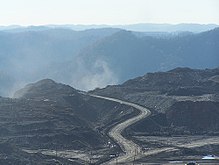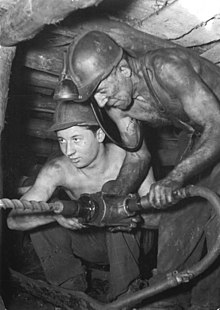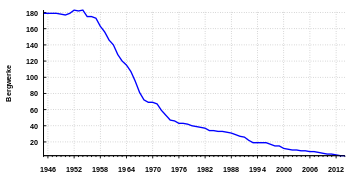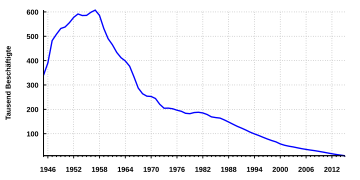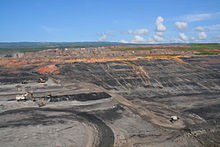Hard coal mining
As coal mining is defined as the exploration for and extraction of coal , which in Day or underground mining can take place. Plants for hard coal extraction (especially in underground mining) are called hard coal mines or collieries .
In 2009 around 6 billion tons of hard coal were mined worldwide. The largest producing countries are the People's Republic of China , the USA and India , which together provide around 73% of world production .
Hard coal is primarily used in power plants to generate electrical energy , and in the case of combined heat and power, it is also used to generate heat . Another important customer are coking plants that refine hard coal into coke , which u. a. is required for steel production.
history
The oldest hard coal mining is documented for the Saarland . In the Heinitz district of Neunkirchen , pieces of jewelery carved from Kännelkohlen of the seam Tauentzien as grave goods from the Hallstatt period to the late Gallo-Romanesque period were proven by coal petrographic methods.
Deposits
Bituminous coal is a sediment made from plant residues that initially form a peat bog and are then covered by other sediments. In the absence of air as well as the effects of pressure and heat, coal can then form. This process is called coalification . The sediment layers consisting of hard coal are called seams . A hard coal deposit exists if the coal can be found in an extensive area with sufficient thickness for mining . Depending on the formation, a distinction is made between limnic and marine deposits.
Mining methods
Depending on the geological conditions, hard coal is extracted both in the opencast and underground .
Open pit
The excavation is carried out either with bucket wheel excavators or with backhoe excavators. The open pit mine has very low production costs due to a high degree of mechanization. The high land consumption and the destruction of the landscape are disadvantageous. Open pit mining on coal is mainly operated in Australia, Kazakhstan and the United States of America.
Civil engineering
Building subsidence often occurs in civil engineering. Running waters have to be saddled up for civil engineering. During the dismantling, daytime facilities must be put into operation and heaps must be created.
Site construction
The construction is a method mainly used in the USA ( English room-and-pillar ). So-called continuous miners are used to drive chessboard-like stretches in the seam. The method is very effective, but has degradation losses of up to 60%.
Longwall mining
The other major mining method today is longwall mining . The coal is mined on a coal front up to 450 m long by peeling with a coal plane or by cutting with a cutter roller . Several thousand tons of coal can be extracted from one face every day. In the past (and possibly still today in not highly developed countries) coal was extracted from the face by miners with a pick hammer and shovel ( tough ).
Environmental impact
The effects of hard coal mining on the environment can be divided into two groups: land use and mining damage . Climate damage from greenhouse gas emissions and general environmental pollution from other emissions arise not only from the mining of hard coal, but also from its utilization, for example when it is burned in power plants to generate electricity.
Open pit
In the case of opencast mining , the impact on the environment is mainly determined by the high land consumption . Further environmental impacts are the lowering of the groundwater and the development of dust.
In the Mountaintop Removal Mining method used in the Appalachian Mountains , entire hilltops are removed in order to extract the coal seams below in open-cast mining. Due to the great thickness of the seams and the relatively small thickness of the overburden, open pit mining with large equipment is more efficient here than underground mining, where subsidence would be so great that most of the mountains would also be destroyed. A theoretical alternative is mining with offset , which, however, would ultimately make the deposits unworthy of construction. Mountain top removal mining is changing the landscape seriously.
Civil engineering / underground mining
In civil engineering , the main effects are the mining damage caused by subsidence . These consist of building damage in built-up areas and the need to saddle up the flowing waters to ensure that they can flow. Furthermore, areas for heaps and day facilities are used during the operating time of a mine . In Germany, tailings piles have had to be designed as landscaping structures since the 1980s, which are re-used as recreational areas or otherwise after the end of their operating hours. The daytime facilities will either be dismantled or reused.
Seam fires
Seam fires can occur either through spontaneous combustion or through human impact, for example as a result of a mine fire . Seam fires caused by spontaneous ignition only occur in seams that consist of types of coal that tend to spontaneously ignite or in which pyrophoric rocks occur in the intermediate center or in the sloping or lying layers. In addition, there must be an oxygen supply , which is why the seam fires caused by self-ignition are limited to seams that bite out at the surface or are connected to the surface through pits. In a hard coal mine, the hard coal can spontaneously ignite if safety precautions are not observed, if residual coal remains in the old man and the old man is supplied with oxygen by creeping weather . The environmental impact of seam fires consists in the emission of CO 2 , CO and other gases from incomplete combustion and, in the case of near-day seam fires, in the loss of the surface area for agricultural or other use.
Situation by state
Germany
Deposits in what is now the Federal Republic of Germany
The most important German deposits are located in North Rhine-Westphalia in the Ruhr area and in Tecklenburger Land ( Ibbenbürener Steinkohlenrevier ) as well as in Saarland ( Saarrevier ). Former coal fields, in which mining has been stopped for a long time, are the Aachener Revier, the Zwickau and the Lugau-Oelsnitz coalfield. In addition, there were many smaller coal mining areas of little or local importance.
Cessation of hard coal mining in Germany
Since the 1960s, the operating costs in West German coal mining have been higher than the revenues generated on the market. The state government of North Rhine-Westphalia and the federal government began to support coal mining with subsidies . Unsubsidized reduction was not profitable due to the cost structures. 2010, the average market price was 85.33 € / t coal equivalent (see coal prices ), while the production costs in Germany amounted to about € 160 / tce. Subsidies stopped in 2018.
For the German hard coal mining, this meant the end of the economy, since the development of the world market price did not suggest any profitable operation in the foreseeable future. Germany's hard coal consumption has been almost constant or has fallen slightly since the mid-1990s, as gas consumption increased over the same period, total energy consumption decreased and renewable energies were expanded significantly (see also wind energy statistics ).
RAG Deutsche Steinkohle AG was the sole operator of the German hard coal mines . On August 17, 2018, coal was mined for the last time in the Ibbenbüren mine and on December 21, 2018, the Prosper-Haniel mine was closed as the last mine in the Ruhr area .
Background subsidy exit
The exit from subsidized hard coal mining for 2018 has been considered a done deal between the state governments and the federal government since January 29, 2007, when the SPD also approved the closure of the mines. The state of North Rhine-Westphalia , which withdrew from subsidy payments in 2015, and the Social Democrats reserved the right to re-examine the feasibility study and the decision in 2012 with regard to social compatibility (so-called “revision clause”). It could therefore not be ruled out that the subsidies would continue to be paid after 2018. An extension after 2018, or an early phase-out before 2018, would have required a change in the Hard Coal Financing Act. Under Kurt Beck (SPD chairman from April 2006 to September 2008), the SPD supported this compromise primarily in order to “save face” from parts of the electorate. The revision clause also applied to the Saarland . In May 2011, the Bundestag and Bundesrat approved the deletion of the revision clause.
Museums in Germany
Several museums today remind of the former German coal mining industry. a .:
- German Mining Museum Bochum
- Saarland Mining Museum in Bexbach in Saarland
- Industrial Museum Zeche Zollern in Dortmund
- Museum of Industrial Culture in Osnabrück
- Mining Museum Oelsnitz / Erzgebirge in Oelsnitz / Erzgebirge (former Kaiserin Augusta / Karl Liebknecht shaft) including the Saxon Coal Road
- Nightingale colliery in Witten
- World Heritage Site Zeche Zollverein in Essen
- Reinsdorf Local History and Mining Museum (Saxony)
- German Museum in Munich
- Mining museum in Ibbenbüren
- Rabensteiner Stollen visitor mine in the Harz / Thuringia
Other media
At the end of hard coal production in North Rhine-Westphalia on December 21, 2018 (closure of the last mines in North Rhine-Westphalia : Prosper-Haniel and Anthracite Ibbenbüren ), Westdeutsche Rundfunk, Cologne broadcast a focus. In addition to documentaries, there was a mobile game for Android and iOS called "Arschleder".
Spain
In particular, the Basque Country and Asturias have significant coal mining and an extensive mining industry.
Czech Republic
The mining of hard coal takes place in the Ostrava Basin in the Moravian-Silesian region . In addition, there were other support areas u. a. in the Pilsen basin around Zbůch , in the area around Kladno (west of Prague ), in the Schatzlar area near Lampertice and in the Rossitz - Oslawan area. There was the Důl Jindřich II colliery near Zbýšov, the deepest coal mine in the country at 1550 m; it was shut down in 1992.
Great Britain
In Great Britain , coal mining grew from the 18th century to an essential basis for the industrialization that started there . Since its inception, intense political conflicts over working conditions, the right to strike and the activity of the first trade unions have shaped the change between nationalization and privatization in the 20th century. After the British miners' strike in 1984/1985 , the mining industry and in particular the number of employees was greatly reduced. British hard coal still covers a substantial part of the British electricity demand, but this has decreased significantly since the 1970s and is mainly covered with cheap imported coal. Since 2003 the UK has imported more coal than it produces. The number of workers in the coal industry, which at its peak in the 1920s was over a million (around 280,000 in 1970), dropped to under 5,000 by 2015. The longest continuously producing coal mine in the UK, possibly worldwide, was Tower Colliery in South Wales . Opened in 1805, it survived the politically enforced extensive reduction in coal mining in Great Britain in the 1980s by taking over the workforce. Tower Colliery closed in 2008; production continues in the neighboring Aberpergwym mine . In Great Britain there are plans to reinvigorate British coal mining with the partly controversial Ffos-y-fran Land Reclamation Scheme (open-cast mining) near Merthyr Tydfil in South Wales.
On December 18, 2015, the last operational coal mine, Kellingley Colliery, in North Yorkshire was closed. This ended for the time being the centuries-old underground coal mining in the United Kingdom. However, coal continues to be mined in open-cast mining.
Russia
In 2018, Russia is expected to produce more than 420 million tons of coal. Around half come from the Kuznetsk Basin . Around 50% are exported .
United States
Hard coal was already being mined in the USA at the beginning of the 18th century, and systematically in Midlothian in Virginia from 1730 , and is one of the most important domestic energy sources alongside crude oil . Steel production and industrialization began with the Manufacturing Belt, now known as the Rust Belt .
Australia
With an annual output of 348 million tons in 2009, Australia is one of the most important coal countries in the world. In 2008, Australia was the world's largest hard coal exporter with 260 million tons, most of which was transported to China by bulk carriers . In addition, 85% of Australia's electricity was generated in coal-fired power plants.
China
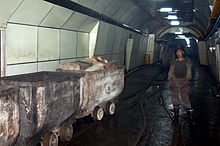
In China , hard coal is mined both in opencast and underground mining. Although China is the largest producer of hard coal with 2.93 billion tons (2009) from approx. 18,000 mines , it now consumes more coal itself than it can extract. While it was able to export a small amount in 2006 , the country has had to import coal since 2007 .
Coal mining in China is made more difficult by coal fires , with large areas of coal igniting. In this way, around 20 million tons of coal are burned annually in China; another 200 million tons will be unusable for mining. In addition, the coal fires endanger the health and lives of people in the immediate vicinity.
Colombia
In Colombia, hard coal is mined both in open pit and underground mining. With El Cerrejón , Colombia has one of the largest open pit coal mines in the world. El Cerrejón alone provided 42% of Colombian production in 2008. Colombia produced 72.8 million tons of hard coal in 2009. It was in 10th place in the list of coal-producing countries. With an export volume of 68.7 million tons (2008), Colombia is in 5th place among the countries exporting hard coal.
The largest coal producers

literature
- European Coal and Steel Community - High Authority: Vocational training in hard coal mining in the countries of the Community . Luxembourg 1956.
- Wilhelm Hermann, Gertrude Hermann: The old mines on the Ruhr. Past and future of a key technology. With a catalog of the "life stories" of 477 mines (series Die Blauen Bücher ). Verlag Langewiesche Nachhaben, Königstein im Taunus, 6th edition, expanded to include an excursus from p. 216 and updated in energy policy parts 2008, ISBN 978-3-7845-6994-9 .
- Hans Röhrs : The Ibbenbürener mining of the 20th century in pictures . Ibbenbürener Vereindruckerei, Ibbenbüren 1998, ISBN 3-921290-94-5 .
- Hans Röhrs: Ibbenbürener hard coal and ore mining and its minerals . Bode, Haltern in Westphalia 1991.
- Hubert Rickelmann and Hans Röhrs : Ibbenbürener hard coal mining from the beginning to the present . Schöningh, Paderborn, Munich, Vienna and Zurich 1987, ISBN 3-506-77223-6 .
- Georg Küffner: Hard coal mining. Drive to zero in a controlled manner. In: Frankfurter Allgemeine Zeitung. October 18, 2012, accessed October 28, 2012 .
- Uwe Burghardt: With full mechanization against decline. Hard coal mining in northern France and western Germany in the post-war era . In: Technikgeschichte, Vol. 61 (1994), H. 2, pp. 83-109.
- Kathy O'Donnell: Technical developments in British coal mining after 1945 . In: Technikgeschichte, Vol. 61 (1994), H. 2, pp. 111-133.
- Ruth Edgecombe and Ian Phimister: The South African Coal Industry 1945-1993. Technological responses to changing market patterns . In: Technikgeschichte, Vol. 61 (1994), H. 2, pp. 135-164.
- Don Dingsdag: The coal mining in Australia after the Second World War . In: Technikgeschichte, Vol. 61 (1994), H. 2, pp. 165-194.
Web links
Individual evidence
- ↑ H. Engel: Palnyology in the service of archeology . In: Coal Petrographic Institute (ed.): Working group palaeobotany and paleyology . Krefeld 1989.
- ↑ Josh Gabbatiss: Coal mines emit more methane than oil-and-gas sector, study finds. Carbon Brief, March 24, 2020, accessed on March 29, 2020 .
- ↑ Germany: Consumption. (PDF, 12 kB) Retrieved January 28, 2013 .
- ↑ The last coals are funded Ibbenbürener Volkszeitung from August 24, 2018
- ↑ (tso / dpa): Mining: 2018 is the end of German hard coal. In: zeit.de . January 28, 2007, accessed January 5, 2017 .
- ↑ Exit 2018: SPD approves colliery closure. In: Spiegel Online . January 29, 2007, accessed January 5, 2017 .
- ↑ bundesrat.de ( Memento from August 28, 2011 in the Internet Archive )
- ↑ bundestag.de: February 17, 2011: Printed matter 17/4805 (PDF, 103 kB)
- ↑ Kathrin Witsch: One last “Glück auf!” - An era ends for Germany with hard coal. In: handelsblatt.de . 20th December 2018.
- ↑ Layer in the shaft - farewell to the coal. In: Topic page, WDR. WDR, Cologne, accessed on December 21, 2018 .
- ↑ Ass leather: the smartphone game about mining. WDR, December 14, 2018, accessed January 3, 2019 .
- ↑ a b Closure of Kellingley pit brings deep coal mining to an end. BBC News, December 18, 2015, accessed December 18, 2015 .
- ↑ Protest halts opencast mine work. In: news.bbc.co.uk. December 5, 2007, accessed January 5, 2017 .
- ↑ Sadness tinged with relief for miners as Kellingley Colliery closure date set. (No longer available online.) Yorkshire Evening Post, December 14, 2015, archived from the original on December 22, 2015 ; accessed on December 18, 2015 .
- ↑ Thielko Grieß: Russian coal for Germany: “The people, water and air suffer from it”. In: deutschlandfunk.de . December 3, 2018, accessed December 23, 2018 .
- ↑ Imported coal. In: kohleausstieg-berlin.de. Retrieved December 23, 2018 .
- ↑ Historical Overview Of The Midlothian Coal Mining Company Tract, Chesterfield County, Virginia ( April 19, 2007 memento in the Internet Archive ), Martha W. McCartney, December, 1989.
- ^ The Importance of Coal in the Modern World - Australia ( Memento of February 8, 2007 in the Internet Archive )

